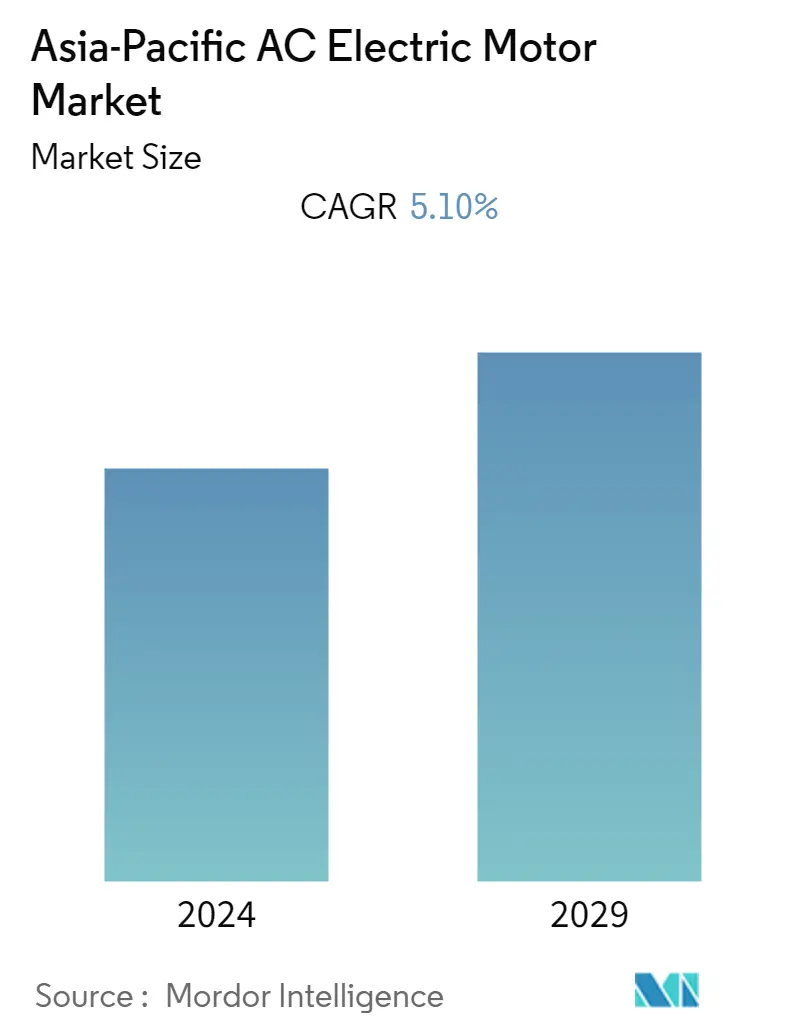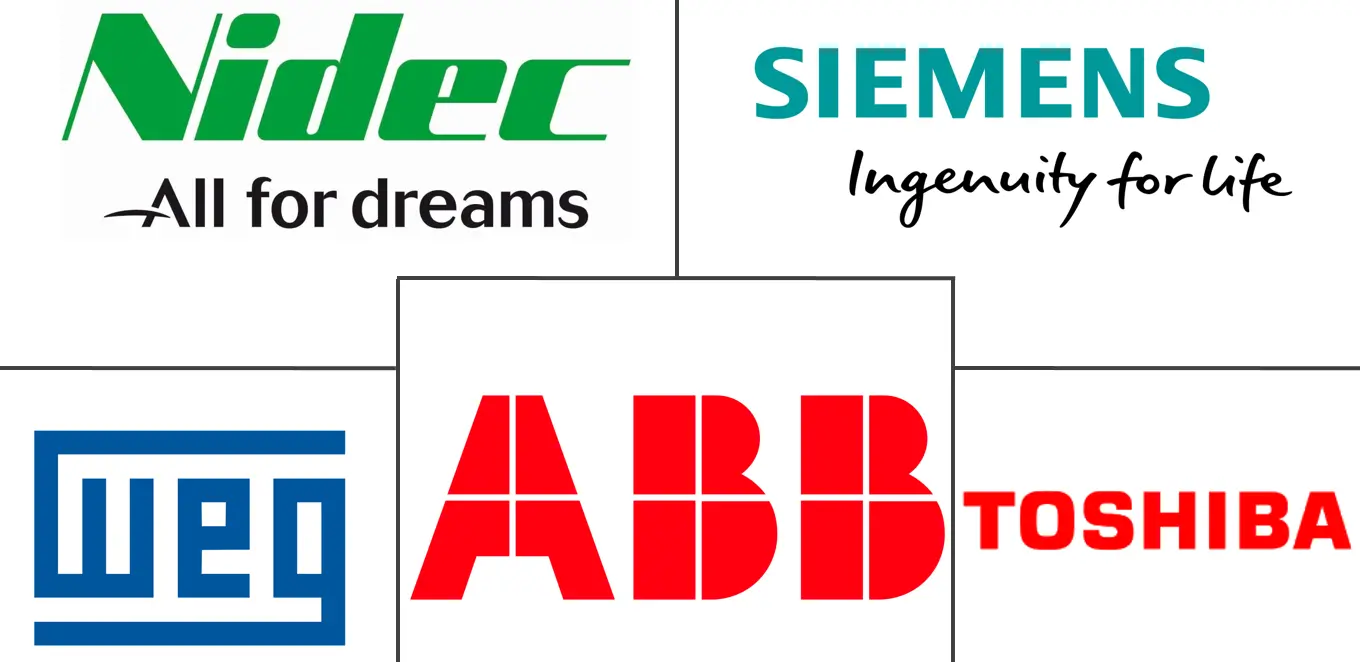Market Size of Asia-Pacific AC Electric Motor Industry

| Study Period | 2019 - 2029 |
| Base Year For Estimation | 2023 |
| Forecast Data Period | 2024 - 2029 |
| Historical Data Period | 2019 - 2022 |
| CAGR | 5.10 % |
| Market Concentration | Medium |
Major Players
*Disclaimer: Major Players sorted in no particular order |
APAC Ac Electric Motor Market Analysis
Asia-Pacific AC Electric Motor market is expected to grow at 5.1% CAGR during the forecast period of 2021-2026. Industrial automation, which drives the manufacturing sector worldwide, is expected to show strong growth during the forecasted period. The Asia-Pacific region is expected to open up new growth opportunities in the AC electric motor market over and beyond the forecast period. However, the higher initial investment for procuring new equipment and upgrading existing equipment and portability issues with AC motors could restrain the market's growth.
- Electric vehicles are expected to boost the growth of the market studied over the forecast period. The number of new EV cars registered in the Asia Pacific hit an unprecedented market share in 2019, with the developed economies supporting this trend. With the leading automotive companies increasingly adopting AC electric motors into EVs, the regional demand is expected to increase, thus driving the market growth.
- In May 2019, the American Chamber of Commerce in China found that 40% of its surveyed members had either begun to shift their production facilities outside of China or were thinking of moving their production out of the country. Of those planning to leave the country, more than half listed Southeast Asia as the prime location they consider relocating. This will further boost Southeast Asia's industrial production, therefore driving the growth of the market.
- Manufacturers across the Asia Pacific region have been identified to integrate PMAC motors into their manufacturing facilities, to increase the plant's operational efficiency. It has been proved that PMAC motors operate with around 4% higher productivity at full speed, 7%-12% higher efficiency at half the pace, and about 24% higher efficiency at 1/6th speed, as compared to conventional motors.
- Major manufacturers are switching to PMAC motors in the region, also creating opportunities for the market. For instance, in September 2019, Tata Motors announced the use of a PMAC motor in its new range of EVs to replace the AC induction motor it has employed previously. Tata Motor's previous EV, the Tigor EV, had a 30kW 72V AC induction motor coupled with a 16.2kWh battery, giving it a maximum range of 88 miles. The new Ziptron EV, using a PMAC motor, claims to have a range of 155 miles with fast charging capability.
- The industrial sector in Asia-Pacific is also expected to witness massive growth due to various government initiatives like 'Make in China 2025' and 'Make in India,' which may promote the usage of AC electric motors, thereby driving its growth in the region.
- Industrial manufacturing companies are grappling with the immediate effect of the COVID-19 pandemic as both their manufacturing and supply chain operations are disrupted, and their customers' operations face similar threats. This exponentially affects the whole supply and distribution network, hitting Industrial Equipment companies with a lag. This will act as a significant challenge for the Asia-pacific AC electric motor market for a considerable period.
- According to World Bank statistics, China's industrial production is expected to decrease by 22.6% compared to the previous year. The effect of COVID-19 containment measures is visible in data on industrial production in China, which has fallen by 13.5% in January and February combined, compared with the previous year.
APAC Ac Electric Motor Industry Segmentation
Recent technological advancements and implementation of government policies like Minimum Energy Performance Standards (MEPS) in several Asia-Pacific countries gave rise to energy-efficient motor systems, therefore increasing the market share of the AC electric motors. The market scope of Asia-Pacific AC electric motors tracks down the adoption of different AC motor types used by several end-user industries such as oil & gas, chemicals & petrochemicals, power generation, etc. The study also focuses on the impact of COVID-19 on the market ecosystem. In the report scope, the existing vendor landscape also covered, which consists of major players operating in the market.
| Voltage | |
| Low | |
| Medium | |
| High |
| Type of Motor | |
| AC Induction/Asynchronous | |
| AC Synchronous (including PMAC) |
| End User Industry | |
| Oil & Gas | |
| Power Generation | |
| Water & Wastewater | |
| Food & Beverage | |
| Other End User Industries |
| Country | |
| China | |
| India | |
| Japan | |
| Australia and New Zealand | |
| Rest of Asia Pacific |
Asia-Pacific AC Electric Motor Market Size Summary
The Asia-Pacific AC electric motor market is poised for significant growth, driven by industrial automation and the increasing adoption of electric vehicles. The region's focus on enhancing manufacturing efficiency and the integration of advanced motor technologies, such as Permanent Magnet AC (PMAC) motors, is expected to bolster market expansion. Despite challenges like high initial investment costs and portability issues, the market is supported by government initiatives and the shift of production facilities to Southeast Asia, which is anticipated to enhance industrial production. The demand for low voltage motors, particularly in sectors like water treatment and oil and gas, further underscores the region's robust market potential.
The competitive landscape of the Asia-Pacific AC electric motor market is characterized by the presence of major global and regional players who are actively engaging in research and development, strategic partnerships, and innovative product launches to maintain their market share. Companies such as Wolong, ABB, and Siemens dominate the low voltage motor segment, while advancements in smart digital solutions and environmentally friendly motor designs are shaping future market dynamics. The market's growth trajectory is also influenced by the recovery of industrial activities post-COVID-19, with a gradual increase in demand from various end-user industries expected to drive the market forward.
Asia-Pacific AC Electric Motor Market Size - Table of Contents
-
1. MARKET INSIGHTS
-
1.1 Market Overview
-
1.2 Industry Attractiveness - Porter's Five Forces Analysis
-
1.2.1 Threat of New Entrants
-
1.2.2 Bargaining Power of Buyers/Consumers
-
1.2.3 Bargaining Power of Suppliers
-
1.2.4 Threat of Substitute Products
-
1.2.5 Intensity of Competitive Rivalry
-
-
1.3 Distribution Channel Analysis
-
-
2. MARKET SEGMENTATION
-
2.1 Voltage
-
2.1.1 Low
-
2.1.2 Medium
-
2.1.3 High
-
-
2.2 Type of Motor
-
2.2.1 AC Induction/Asynchronous
-
2.2.2 AC Synchronous (including PMAC)
-
-
2.3 End User Industry
-
2.3.1 Oil & Gas
-
2.3.2 Power Generation
-
2.3.3 Water & Wastewater
-
2.3.4 Food & Beverage
-
2.3.5 Other End User Industries
-
-
2.4 Country
-
2.4.1 China
-
2.4.2 India
-
2.4.3 Japan
-
2.4.4 Australia and New Zealand
-
2.4.5 Rest of Asia Pacific
-
-
Asia-Pacific AC Electric Motor Market Size FAQs
What is the current Asia-Pacific AC Electric Motor Market size?
The Asia-Pacific AC Electric Motor Market is projected to register a CAGR of 5.10% during the forecast period (2024-2029)
Who are the key players in Asia-Pacific AC Electric Motor Market?
ABB Ltd., Siemens AG, Toshiba Industrial Products and Systems Corporation, Nidec Corporation and Weg SA are the major companies operating in the Asia-Pacific AC Electric Motor Market.

